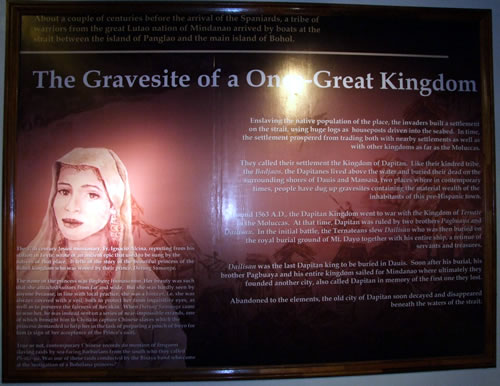Dauis History Part 1 |
The Gravesite of a One Great Kingdom |
 |
| These series of posters posted in the walls of Cafe Lawis depics the history of Dauis and ancient buried treasures. Text of the poster as re-written below: |
Upper Left : About a couple of centuries ago before the arrival of the Spaniards, A tribe of warriors from The Great Lutao Nation of Mindanao arrived by boats at the Strait between the island of Panglao and the mainland of Bohol.
|
Middle Right : Enslaving the native population of the place, the invaders buit a settlement on the strait using huge logs as housepost driven into the seabed. In time, the settlement prospered from trading both with nearby settlement as well as other kingdoms as far as the Moluccas. They called their settlement The Kingdom of Dapitan. Like their kindred tribe, the Badjaos, the Dapitanes, lived above the water and burried their dead on the sorrounding shores of Dauis and Mansasa. two places where in contemporary times, people have dug up gravesites containing the material wealth of the inhabitants of this pre-hispanic town. Around 1563 AD., the Dapitan Kingdom went to war with the Kingdom of Ternate in the Moluccas. At that time Dapitan was ruled by two brothers Pagbuaya and Dailisan. In the initial battle, the Ternateans slew Dailisan who was then burried in the royal burial ground of Mt. Dayo together with his entire ship, a retinue of servants and treasures. Dailisan was the last Dapitan king to be burried in Dauis. Soon after his burial, his brother Pagbuaya and his entire kingdom sailed for Mindanao where ultimately they founded another city called Dapitan. in memory of the first one they lost. Abandoned to the elements, the old city of Dapitan soon decayed and disappeared beneath the waters of the strait.
|
Lower left : The 17th century Jesuit missionary, Fr. Ignacio Alcina, reporting from his station in Leyte, wrote of an ancient epic that used to be sung by the natives of that place. It tells of a story of the beautiful princess of the Bohol Kingdom who was wooed by their prince, Datung Sumanga. The name of the princess was Bugbung Humasanum. Her beauty was such that she attracted suitors far and wide. But she was hardly seen by anyone because, in line with the local practice, she was binukot, i.e. she was always covered by a veil, both to protect her from the inquisitive eyes, as well as to preserve the fairness of her skin. when Datung Sumanga came to woo her, he was instead sent on a series of near-impossible errands, one of which brought him to China to capture Chinese slaves which the princess demanded to help her in the task of preparing apouch of buyo for him (a sign of her acceptancce of the prince's suit). True or not, contemporary Chinese records do mention of frequent slaving raids by sea-faring barbarians from the south who they called Pi-she-ya. Was one of these raids conducted by the Bisaya band who came at the instigation of a Boholana princess? |
DiscoverBohol.com, copyright 2006 - 2015, All Rights Reserved |
Follow us on: |
facebook |
twitter |




